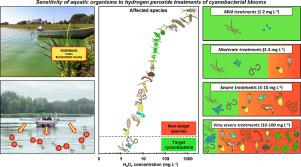Water Research ( IF 12.8 ) Pub Date : 2022-09-27 , DOI: 10.1016/j.watres.2022.119169 Erik F J Weenink 1 , Michiel H S Kraak 1 , Corné van Teulingen 1 , Senna Kuijt 1 , Maria J van Herk 1 , Corrien A M Sigon 1 , Tim Piel 1 , Giovanni Sandrini 2 , Mariël Leon-Grooters 3 , Milo L de Baat 4 , Jef Huisman 1 , Petra M Visser 1

|
Addition of hydrogen peroxide (H2O2) is a promising method to acutely suppress cyanobacterial blooms in lakes. However, a reliable H2O2 risk assessment to identify potential effects on non-target species is currently hampered by a lack of appropriate ecotoxicity data. The aim of the present study was therefore to quantify the responses of a wide diversity of freshwater phytoplankton, zooplankton and macroinvertebrates to H2O2 treatments of cyanobacterial blooms. To this end, we applied a multifaceted approach. First, we investigated the 24-h toxicity of H2O2 to three cyanobacteria (Planktothrix agardhii, Microcystis aeruginosa, Anabaena sp.) and 23 non-target species (six green algae, eight zooplankton and nine macroinvertebrate taxa), using EC50 values based on photosynthetic yield for phytoplankton and LC50 values based on mortality for the other organisms. The most sensitive species included all three cyanobacterial taxa, but also the rotifer Brachionus calyciflores and the cladocerans Ceriodaphnia dubia and Daphnia pulex. Next, the EC50 and LC50 values obtained from the laboratory toxicity tests were used to construct a species sensitivity distribution (SSD) for H2O2. Finally, the species predicted to be at risk by the SSD were compared with the responses of phytoplankton, zooplankton and macroinvertebrates to two whole-lake treatments with H2O2. The predictions of the laboratory-based SSD matched well with the responses of the different taxa to H2O2 in the lake. The first lake treatment, with a relatively low H2O2 concentration and short residence time, successfully suppressed cyanobacteria without major effects on non-target species. The second lake treatment had a higher H2O2 concentration with a longer residence time, which resulted in partial suppression of cyanobacteria, but also in a major collapse of rotifers and decreased abundance of small cladocerans. Our results thus revealed a trade-off between the successful suppression of cyanobacteria at the expense of adverse effects on part of the zooplankton community. This delicate balance strongly depends on the applied H2O2 dosage and may affect the decision whether to treat a lake or not.
中文翻译:

浮游植物、浮游动物和大型无脊椎动物对过氧化氢处理蓝藻水华的敏感性
添加过氧化氢 (H 2 O 2 ) 是一种很有前途的方法,可以有效抑制湖泊中的蓝藻水华。然而,目前缺乏适当的生态毒性数据阻碍了可靠的 H 2 O 2风险评估以确定对非目标物种的潜在影响。因此,本研究的目的是量化各种淡水浮游植物、浮游动物和大型无脊椎动物对 H 2 O 2处理蓝藻水华的反应。为此,我们采用了多方面的方法。首先,我们研究了 H 2 O 2对三种蓝藻的 24 小时毒性(Planktothrix agardhii, Microcystis aeruginosa, Anabaena sp.) 和 23 个非目标物种(6 种绿藻,8 种浮游动物和 9 种大型无脊椎动物分类群),使用基于浮游植物光合产量的EC 50值和基于其他生物死亡率的LC 50值. 最敏感的物种包括所有三种蓝藻类群,还有轮虫Brachionus calyciflores和枝角类Ceriodaphnia dubia和Daphnia pulex。接下来,使用从实验室毒性测试中获得的 EC 50和 LC 50值来构建 H 2 O 2的物种敏感性分布 (SSD). 最后,将被 SSD 预测为危险的物种与浮游植物、浮游动物和大型无脊椎动物对两种全湖 H 2 O 2处理的反应进行了比较。基于实验室的 SSD 的预测与湖中不同类群对 H 2 O 2的响应非常吻合。第一个湖泊处理具有相对较低的 H 2 O 2浓度和较短的停留时间,成功地抑制了蓝藻,而对非目标物种没有重大影响。第二个湖处理具有较高的 H 2 O 2停留时间较长的浓度,导致蓝细菌的部分抑制,但也导致轮虫的主要崩溃和小枝角类动物的丰度减少。因此,我们的研究结果揭示了成功抑制蓝藻以牺牲对部分浮游动物群落的不利影响之间的权衡。这种微妙的平衡很大程度上取决于施加的 H 2 O 2剂量,并可能影响是否处理湖泊的决定。


























 京公网安备 11010802027423号
京公网安备 11010802027423号